We can all relate to the benefit of decent curtains, when it’s cold out you can feel the difference between the air in the room and the air in front of the windows, and when it’s warm out you can feel the relief of drawing them to make some shade. But most of us underestimate just how useful they can be in regulating indoor temperatures and reducing energy costs. Whether you’re a homeowner or a renter, optimizing your curtain setup can help you stay warm in winter and cool in summer. A 2017 review by Fitton, Swan, Hughes & Benjaber brings a great deal of insight in The thermal performance of window coverings in a whole house test facility with single-glazed sash windows.
How curtains affect indoor temperature
Curtains and blinds can act as insulators, forming a barrier that slows down the transfer of heat between the inside and outside of your home. According to a study by Baker (2008), energy savings from using curtains can range from 41% to 62%, depending on the type and installation of window coverings.
Similarly, Garber-Slaght and Craven (2012) found that savings of 24% to 38% were achievable when using well-fitted window coverings. The effectiveness of a curtain in conserving energy largely depends on how well it is sealed against the window frame, where you need to aim for as air-tight as possible. Creating a stationary air gap between the curtain and the window can significantly reduce heat transfer. The wider the air gap, the higher the insulating effect, as noted by Nicol (1986) and Ruyssevelt and Littler (1984).
Identifying problem areas
Thermal images illustrate how air can circulate around poorly fitted curtains, where you can see cold air pouring through a gap between the wall and the curtain. The cooler areas (marked in blue and purple) indicate where cold air is seeping through, highlighting the importance of securing curtains closer to the wall or using magnetic or Velcro seals to minimize drafts.
Feather (1980) emphasized that the driving factor in energy savings was not necessarily the curtain’s weight or type but how well the curtain was fixed at the perimeter. This fixing creates the above-mentioned layer of stationary air that adds to the insulative effect of the window covering.

Tips for getting the best energy efficiency from your curtains
- Install a pelmet
A pelmet is a box-like structure that covers the top edge of a curtain. It helps to block the flow of warm air over the top of the curtain and prevents heat loss. This simple addition can significantly enhance thermal performance.
- Don’t overhang or cover radiators
Full-length curtains are often chosen for looks or style, but in many cases they end up covering radiators and limiting precious heat from spreading to the room, sending it up and towards the windows instead. Try to fit curtains into the window recess and not covering radiators.
- Opt for thermal or insulated curtains
Curtains made with thermal or insulated linings provide an extra layer of protection against temperature changes. For curtains made up of multiple layers, e.g. with batting, the stitching pattern was found to have the most negative serious impact, where those with more perforations from the stitching pattern performed worse. Higher thread count materials were found to be best at limiting air movement, and wool and velvet ranked best of all in density and improving thermal resistance.
- Ensure a tight fit
Curtains that hang loosely away from the window will allow air to circulate behind them, reducing their effectiveness. Consider installing magnetic or Velcro seals to create a more airtight barrier. Fang (2001) found an improved U value of around 19% with a sealed-edged curtain rather than a loose-edged curtain on a single-glazed window.
- Layer your window furnishings
Layering curtains with blinds or shades can further enhance the insulating effect. This approach was supported by Woodson et al. (1986), who found that multi-layered treatments significantly improved thermal resistance.
- Adapt to the weather and seasons
Keep curtains open during sunny days in winter to let in natural warmth, and close them at night to trap the heat. In summer, keep them closed during the hottest part of the day to prevent overheating.
Small adjustments, big savings
By making small adjustments to how you install and use curtains, you can significantly improve your home’s thermal efficiency. Properly fitted curtains can prevent heat loss in winter and keep your rooms cooler in summer, ultimately reducing your energy bills.
Take a moment to inspect your current window coverings. Are they effectively blocking drafts, or could they use some adjustments? Implementing these cost-effective strategies can make a real difference in your comfort and energy consumption.

